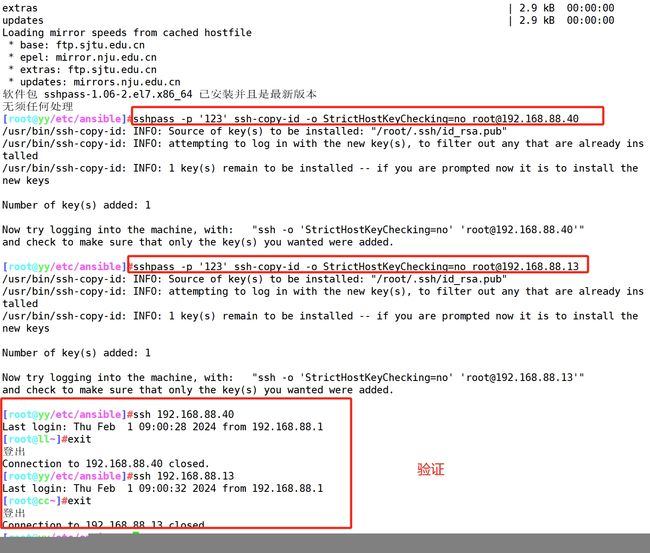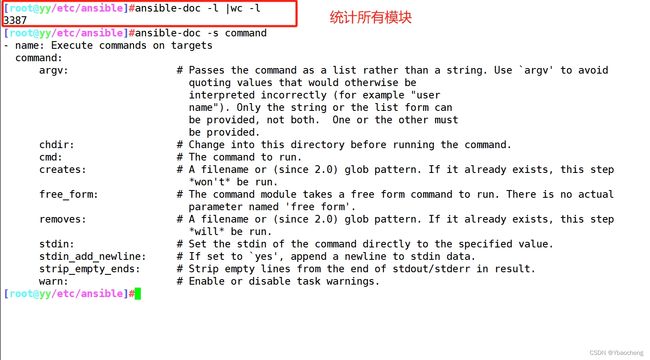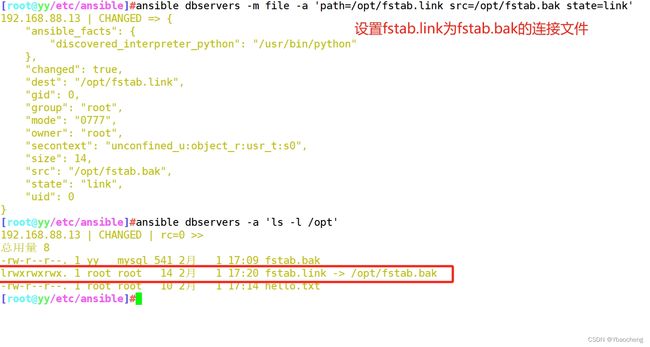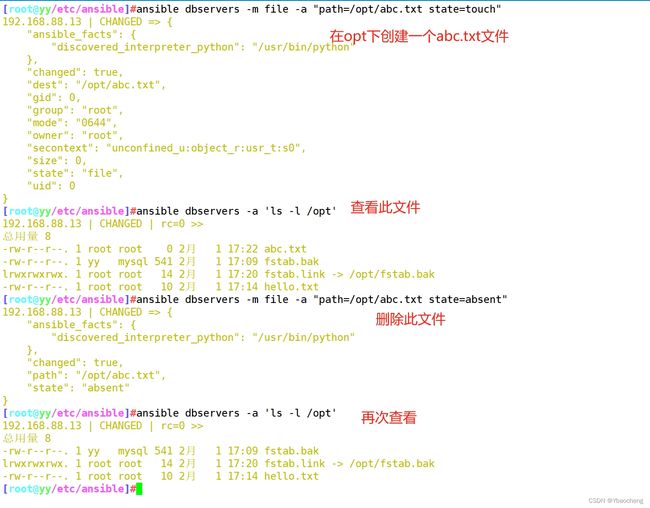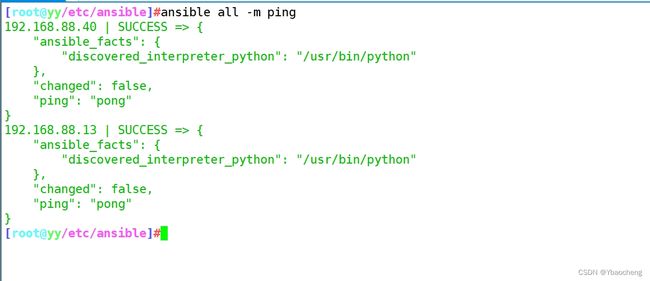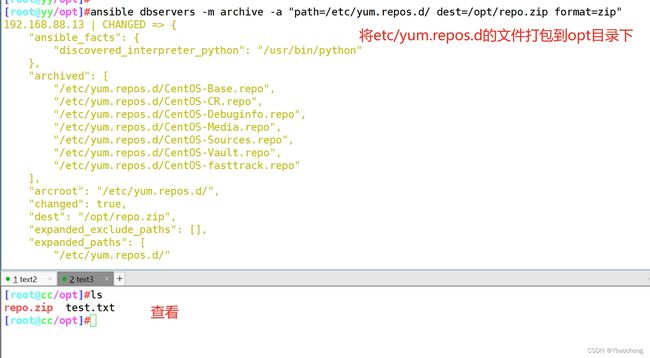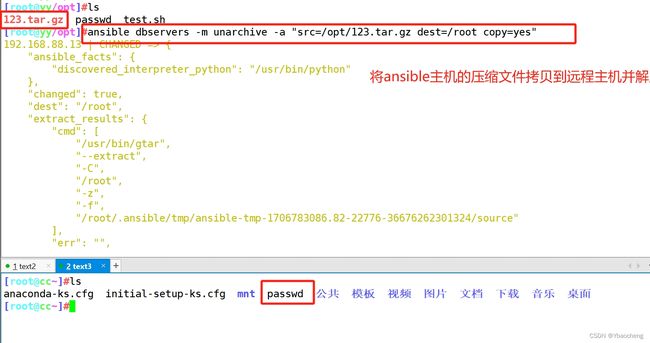Ansible基础及常用模块
目录
1.前言
Ansible
Ansible的特性
2.ansible环境安装部署
管理端安装ansible(192.168.88.22)
ansible目录结构
配置主机清单
配置密钥对验证
3.ansible命令行模块
command 模块
shell 模块
编辑cron 模块
user 模块
group 模块
copy 模块
file 模块
hostname 模块
ping 模块
yum|apt 模块
service/systemd 模块
script 模块
mount 模块
archive 模块
unarchive 模块
replace 模块
setup 模块
1.前言
Ansible
- ansible 自动化运维工具,也叫机器管理工具。可以实现批量管理成百上千的多台主机,是应用级别的跨主机编排工具。
- Ansible能批量配置、部署、管理上千台主机。比如以前需要切换到每个主机上执行的一或多个操作,使用Ansible只需在固定的一台Ansible控制节点上去完成所有主机的操作。
- Ansible是基于模块工作的,它只是提供了一种运行框架,它本身没有完成任务的能力,真正执行操作的是Ansible的模块, 比如copy模块用于拷贝文件到远程主机上,service模块用于管理服务的启动、停止、重启等。
- Ansible其中一个比较鲜明的特性是Agentless,即无Agent的存在,它就像普通命令一样,并非C/S软件,也只需在某个作为控制节点的主机上安装一次Ansible即可,通常它基于ssh连接来控制远程主机,远程主机上不需要安装Ansible或其它额外的服务。
- 使用者在使用时,在服务器终端输入命令或者playbooks,会通过预定好的规则将playbook拆解为play,再组织成ansible可以识别的任务,调用模块和插件,根据主机清单通过SSH将临时文件发给远程的客户端执行并返回结果,执行结束后自动删除
- Ansible的另一个比较鲜明的特性是它的绝大多数模块都具备幂等性(idempotence)。所谓幂等性,指的是无论执行多少次同样的运算,结果都是相同的,即一条命令,任意多次执行所产生的影响均与一次执行的影响相同。比如执行 systemctl stop xxx 命令来停止服务,当发现要停止的目标服务已经处于停止状态,它什么也不会做, 所以多次停止的结果仍然是停止,不会改变结果,它是幂等的,而 systemctl restart xxx 是非幂等的。
- Ansible的很多模块在执行时都会先判断目标节点是否要执行任务,所以,可以放心大胆地让Ansible去执行任务,重复执行某个任务绝大多数时候不会产生任何副作用。
Ansible的特性
- 无客户端agent的存在,不需要在被控制的节点上安装任何客户端应用。
- 通过ssh协议与被控制节点通信
- 基于模块工作的,可以通过模块实现在被控制节点上执行相应的命令操作
- 很多模块具有幂等性,即可实现多次模块操作的状态如果没有发生改变,则不会重复执行
2.ansible环境安装部署
实验准备:
管理端:192.168.88.22 ansible
被管理端:192.168.88.40
被管理端:192.168.88.13管理端安装ansible(192.168.88.22)
yum install -y epel-release //先安装 epel 源
yum install -y ansible
ansible目录结构
/etc/ansible/
├── ansible.cfg #ansible的配置文件,一般无需修改
├── hosts #ansible的主机清单,用于存储需要管理的远程主机的相关信息
└── roles/ #公共角色目录配置主机清单
cd /etc/ansible
vim hosts
[webservers] #配置组名
192.168.88.40 #组里包含的被管理的主机IP地址或主机名(主机名需要先修改/etc/hosts文件)
[dbservers]
192.168.88.13配置密钥对验证
ssh-keygen -t rsa -P '' -f ~/.ssh/id_rsa
yum install -y sshpass
sshpass -p '123' ssh-copy-id -o StrictHostKeyChecking=no [email protected]
sshpass -p '123' ssh-copy-id -o StrictHostKeyChecking=no [email protected] 3.ansible命令行模块
命令格式:
ansible <组名> -m <模块> -a <参数列表>
查看模块
ansible-doc -l #列出当前ansible的所有模块
ansible-doc -s 模块名 #查看指定模块的信息command 模块
- 在远程主机执行linux命令,但不支持管道、重定向等特殊符合,是ansible的默认模块
ansible-doc -s command #-s 列出指定模块的描述信息和操作动作
例:
ansible 192.168.88.40 -m command -a 'date' #指定 ip 执行 date
ansible webservers -m command -a 'date' #指定组执行 date
ansible dbservers -m command -a 'date'
ansible all -m command -a 'date' #all 代表所有 hosts 主机
ansible all -a 'ls /' #如省略 -m 模块,则默认运行 command 模块
常用的参数:
chdir:在远程主机上运行命令前提前进入目录
creates:判断指定文件是否存在,如果存在,不执行后面的操作
removes:判断指定文件是否存在,如果存在,执行后面的操作
ansible all -m command -a "chdir=/home ls ./"shell 模块
- 在远程主机执行linux命令,支持管道、重定向等特殊符合
ansible-doc -s shell
例;
ansible dbservers -m shell -a 'echo 123456 | passwd --stdin yy'
ansible dbservers -m shell -a 'echo $(ifconfig ens33 | awk "NR==2 {print $2}") | cut -d " " -f2'
ansible dbservers -m shell -a 'echo $(ifconfig ens33 | awk "NR==2 {print \$2}")'
 cron 模块
cron 模块
- 在远程主机设置crontab计划任务
ansible-doc -s cron #按 q 退出
//常用的参数:
minute/hour/day/month/weekday:分/时/日/月/周
job:任务计划要执行的命令
name:任务计划的名称
user:指定计划任务属于哪个用户,默认是root用户
例:
ansible webservers -m cron -a 'minute="*/1" job="/bin/echo helloworld" name="test crontab"'
ansible webservers -a 'crontab -l'
ansible webservers -m cron -a 'name="test crontab" state=absent'
state=present|absentuser 模块
- 在远程主机设管理用户账户
常用的参数:
name:用户名,必选参数
state=present|absent:创建账号或者删除账号,present表示创建,absent表示删除
system=yes|no:是否为系统账号
uid:用户uid
group:用户基本组
groups: 用户所属附加组
shell:默认使用的shell
create_home=yse|no: 是否创建家目录
password:用户的密码,建议使用加密后的字符串
remove=yes|no:当state=absent时,是否删除用户的家目录
例:
ansible dbservers -m user -a 'name="cc"' #创建用户cc
ansible dbservers -m command -a 'tail /etc/passwd'
ansible dbservers -m user -a 'name="cc" state=absent' #删除用户cc
state=present|absentgroup 模块
- 在远程主机设管理组账户
ansible-doc -s group
ansible dbservers -m group -a 'name=mysql gid=306 system=yes' #创建mysql组
ansible dbservers -a 'tail /etc/group'
ansible dbservers -m user -a 'name=yy uid=306 system=yes group=mysql' #将test01用户添加到mysql组中
ansible dbservers -a 'tail /etc/passwd'
ansible dbservers -a 'id yy'
state=present|absentcopy 模块
- 将ansible主机的文件/目录/内容复制到远程主机
常用的参数:
dest:指出复制文件的目标及位置,使用绝对路径,如果源是目录,指目标也要是目录,如果目标文件已经存在会覆盖原有的内容
src:指出源文件的路径,可以使用相对路径或绝对路径,支持直接指定目录,如果源是目录则目标也要是目录
mode:指出复制时,目标文件的权限
owner:指出复制时,目标文件的属主
group:指出复制时,目标文件的属组
content:指出复制到目标主机上的内容,不能与src一起使用
例:
ansible dbservers -m copy -a 'src=/etc/fstab dest=/opt/fstab.bak owner=root mode=640'
ansible dbservers -a 'ls -l /opt'
ansible dbservers -a 'cat /opt/fstab.bak'
ansible dbservers -m copy -a 'content="helloworld" dest=/opt/hello.txt' #将helloworld写入/opt/hello.txt文件中
ansible dbservers -a 'cat /opt/hello.txt' file 模块
- 在远程主机管理文件/目录
ansible-doc -s file
ansible dbservers -m file -a 'owner=yy group=mysql mode=644 path=/opt/fstab.bak' #修改文件的属主属组权限等
ansible dbservers -m file -a 'path=/opt/fstab.link src=/opt/fstab.bak state=link' #设置/opt/fstab.link为/opt/fstab.bak的链接文件
ansible dbservers -m file -a "path=/opt/abc.txt state=touch" #创建一个文件
ansible dbservers -m file -a "path=/opt/abc.txt state=absent" #删除一个文件
state=present|absent|touch|directory|link
src(指定软链接的源路径,path指定软链接文件理解)hostname 模块
- 在远程主机设置主机名
用于管理远程主机上的主机名
ansible dbservers -m hostname -a "name=mysql01" #将主机名修改为mysql01ping 模块
- 检测与远程主机的连通性
检测远程主机的连通性
ansible all -m pingyum|apt 模块
- 在远程主机使用yum|apt-get管理软件包
在远程主机上安装与卸载软件包
ansible-doc -s yum
ansible webservers -m yum -a 'name=httpd' #安装服务
ansible webservers -m yum -a 'name=httpd state=absent' #卸载服务
state=present|absent|latestservice/systemd 模块
- 在远程主机使用systemctl管理服务状态
用于管理远程主机上的管理服务的运行状态
ansible-doc -s service
//常用的参数:
name:被管理的服务名称
state=started|stopped|restarted:动作包含启动关闭或者重启
enabled=yes|no:表示是否设置该服务开机自启
runlevel:如果设定了enabled开机自启去,则要定义在哪些运行目标下自启动
ansible webservers -a 'systemctl status httpd' #查看web服务器httpd运行状态
ansible webservers -m service -a 'enabled=true name=httpd state=started' #启动httpd服务
ansible webservers -m service -a 'enabled=false name=httpd state=stopped' #关闭httpd服务
state=started|stopped|restarted|reloaded
enabled=yes|no|true|falsescript 模块
- 在远程主机执行ansible主机上的shell脚本
实现远程批量运行本地的 shell 脚本
ansible-doc -s script
vim test.sh
#!/bin/bash
echo "hello ansible from script" > /opt/script.txt
chmod +x test.sh
ansible webservers -m script -a 'test.sh'
ansible webservers -a 'cat /opt/script.txt'
vim test.sh
#!/bin/bash
echo $1 > /opt/test.txt
echo $2 >> /opt/test.txt
ansible dbservers -m script -a 'test.sh abc 123!'mount 模块
- 在远程主机执行挂载、解挂操作
挂载文件系统
ansible-doc -s mount
//常用的参数:
src:定义挂载设备的路径
path:定义挂载到哪个目录,必须指定
fstype:指定挂载文件的系统类型,必须指定,xfs、iso9660、nfs...
opts:定义挂载的参数,defaults、rw、ro...
state:定义挂载的状态,mounted(进行挂载,修改/etc/fstab信息)、absent(永久性卸载,并修改 /etc/fstab信息)、unmounted(临时卸载,不修改/etc/fstab信息)
ansible dbservers -m mount -a 'src=/dev/sr0 path=/mnt state=mounted fstype=iso9660'
state=mounted|unmounted|absentarchive 模块
- 在远程主机压缩文件/目录
打包压缩
ansible-doc -s archive
//常用的参数:
path: 必须参数,远程主机上需要被打包压缩的源文件/目录
dest: 打包压缩后的包文件路径(包文件的父目录必须存在);如果包文件已存在,则会被覆盖
format: 指定压缩类型,包括: bz2、gz(默认)、tar、xz、zip
remove=yes|no: 是否删除源文件
ansible dbservers -m archive -a "path=/etc/yum.repos.d/ dest=/opt/repo.zip format=zip"
ansible dbservers -m archive -a "path=/opt/abc.txt,/opt/123.txt dest=/opt/abc123.tar.gz format=gz remove=yes"
unarchive 模块
- 将ansible主机上的或远程主机上的压缩包解压缩到远程主机的指定位置
解包解压缩
ansible-doc -s unarchive
常用的参数:
copy:默认为 copy=yes ,拷贝的文件从 ansible 主机复制到远程主机,copy=no 表示在远程主机上寻找源文件解压
src:tar包源路径,可以是 ansible 主机上的路径,也可以是远程主机上的路径,如果是远程主机上的路径,则需设置 copy=no
dest:解压后文件的目标绝对路径
remote_src: 和 copy 功能一样且互斥,设置 remote_src=yes 表示文件在远程主机上,设置为 remote_src=no 表示文件在 ansible 主机上
#将 ansible 主机的压缩文件拷贝到到远程主机并解压,修改文件所属组和用户
ansible dbservers -m unarchive -a "src=/opt/abc.tar.gz dest=/root copy=yes"
或者
ansible dbservers -m unarchive -a "src=/opt/abc.tar.gz dest=/root remote_src=no"
#在远程主机解包
ansible dbservers -m unarchive -a "src=/opt/123.tar.gz dest=/root copy=no"
或者
ansible dbservers -m unarchive -a "src=/opt/123.tar.gz dest=/root remote_src=yes"replace 模块
- 在远程主机修改通过正则表达式匹配的文件内容
类似于sed命令,主要也是基于正则进行匹配和替换
ansible-doc -s replace
//常用的参数:
path:必须参数,指定要修改的文件
regexp:必须参数,指定一个正则表达式
replace:替换regexp参数匹配到的字符串
backup=yes|no: 修改源文件前创建一个包含时间戳信息的备份文件
before:如果指定,则仅替换/删除此匹配之前的内容,可以和after参数结合使用
after:如果指定,则仅替换/删除此匹配之后的内容,可以和before参数结合使用
owner:修改文件用户名
group:修改文件组名
mode:修改文件权限
vim /opt/test.txt
11 22 33 44 55 66
aa bb cc dd ee ff
1a 2b 3c 4d 5e 6f
#匹配 333 并修改为 ccc
ansible dbservers -m replace -a "path=/opt/test.txt regexp='33' replace='cc'"
#匹配到任意一个或多个开头的行增加注释
ansible dbservers -m replace -a "path=/opt/test.txt regexp='^(.*)' replace='#\1'"
#取消注释
ansible dbservers -m replace -a "path=/opt/test.txt regexp='^#(.*)' replace='\1'"
#匹配以 a 开头的后面有一个或者多个字符的行,并在前面添加 # 注释
ansible dbservers -m replace -a "path=/opt/test.txt regexp='^(a.*)' replace='#\1'"
ansible dbservers -m replace -a "path=/opt/test.txt regexp='3' replace='three' before=cc"
setup 模块
- 收集远程主机的系统信息(facts信息)
facts 组件是用来收集被管理节点信息的,使用 setup 模块可以获取这些信息
ansible-doc -s setup
ansible webservers -m setup #获取mysql组主机的facts信息
ansible dbservers -m setup -a 'filter=*ipv4' #使用filter可以筛选指定的facts信息


